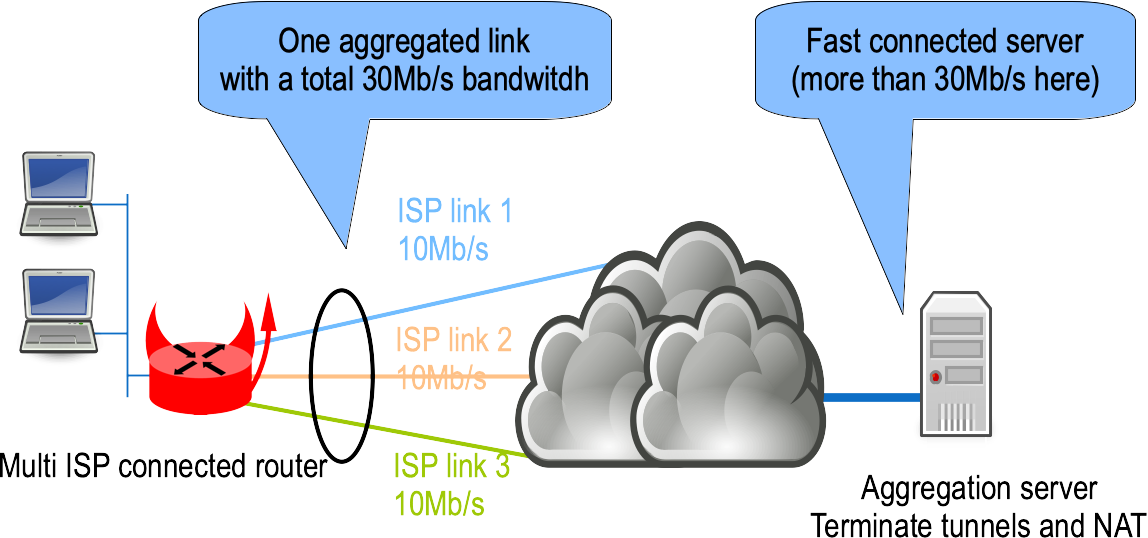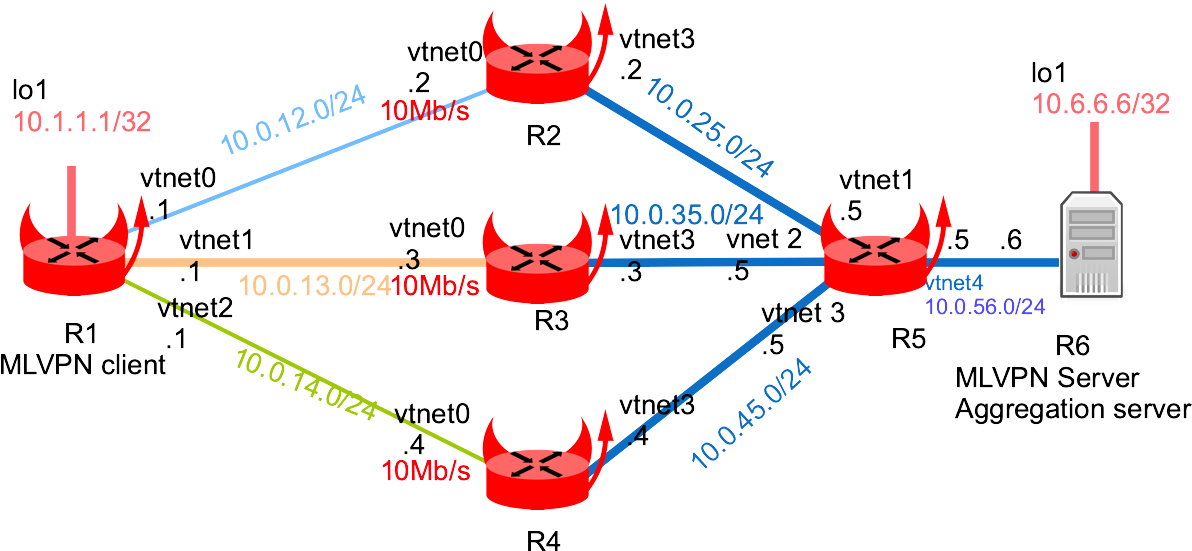Table of Contents
Aggregating multiple ISP links
This lab shows an example of aggregating multiple independent ISP links with MLVPN.
Network diagram
Virtual Lab setup
This chapter will describe how to start each routers and configuring the 4 centrals routers.
More information on these BSDRP lab scripts available on How to build a BSDRP router lab.
Start the Virtual lab (example using bhyve):
# ./tools/BSDRP-lab-bhyve.sh -n 6 BSD Router Project (http://bsdrp.net) - bhyve full-meshed lab script Setting-up a virtual lab with 6 VM(s): - Working directory: /root/BSDRP-VMs - Each VM has a total of 1 (1 cores and 1 threads) and 512M RAM - Emulated NIC: virtio-net - Switch mode: bridge + tap - 0 LAN(s) between all VM - Full mesh Ethernet links between each VM VM 1 has the following NIC: - vtnet0 connected to VM 2 - vtnet1 connected to VM 3 - vtnet2 connected to VM 4 - vtnet3 connected to VM 5 - vtnet4 connected to VM 6 VM 2 has the following NIC: - vtnet0 connected to VM 1 - vtnet1 connected to VM 3 - vtnet2 connected to VM 4 - vtnet3 connected to VM 5 - vtnet4 connected to VM 6 VM 3 has the following NIC: - vtnet0 connected to VM 1 - vtnet1 connected to VM 2 - vtnet2 connected to VM 4 - vtnet3 connected to VM 5 - vtnet4 connected to VM 6 VM 4 has the following NIC: - vtnet0 connected to VM 1 - vtnet1 connected to VM 2 - vtnet2 connected to VM 3 - vtnet3 connected to VM 5 - vtnet4 connected to VM 6 VM 5 has the following NIC: - vtnet0 connected to VM 1 - vtnet1 connected to VM 2 - vtnet2 connected to VM 3 - vtnet3 connected to VM 4 - vtnet4 connected to VM 6 VM 6 has the following NIC: - vtnet0 connected to VM 1 - vtnet1 connected to VM 2 - vtnet2 connected to VM 3 - vtnet3 connected to VM 4 To connect VM'serial console, you can use: - VM 1 : cu -l /dev/nmdm-BSDRP.1B - VM 2 : cu -l /dev/nmdm-BSDRP.2B - VM 3 : cu -l /dev/nmdm-BSDRP.3B - VM 4 : cu -l /dev/nmdm-BSDRP.4B - VM 5 : cu -l /dev/nmdm-BSDRP.5B - VM 6 : cu -l /dev/nmdm-BSDRP.6B
Backbone routers configuration
Router 2
Router 2 is configured for rate-limiting traffic at 10 Mb/s on interface to/from VM1.
sysrc hostname=VM2 \
ifconfig_vtnet0="inet 10.0.12.2/24" \
ifconfig_vtnet3="inet 10.0.25.2/24" \
defaultrouter="10.0.25.5" \
firewall_enable=YES \
firewall_script="/etc/ipfw.rules"
cat > /etc/ipfw.rules <<EOF
#!/bin/sh
fwcmd="/sbin/ipfw"
kldstat -q -m dummynet || kldload dummynet
# Flush out the list before we begin.
\${fwcmd} -f flush
\${fwcmd} pipe 10 config bw 10Mbit/s
\${fwcmd} pipe 20 config bw 10Mbit/s
#Traffic getting out vtnet0 is limited to 10Mbit/s
\${fwcmd} add 1000 pipe 10 all from any to any out via vtnet0
#Traffic getting int vtnet0 is limited to 10Mbit/s
\${fwcmd} add 2000 pipe 20 all from any to any in via vtnet0
#We don't want to block traffic, only shape some
\${fwcmd} add 3000 allow ip from any to any
EOF
service netif restart
service routing restart
service ipfw start
hostname VM2
config save
Router 3
Router 3 is configured for rate-limiting traffic at 10 Mb/s on interface to/from VM1.
sysrc hostname=VM3 \
ifconfig_vtnet0="inet 10.0.13.3/24" \
ifconfig_vtnet3="inet 10.0.35.3/24" \
defaultrouter="10.0.35.5" \
firewall_enable=YES \
firewall_script="/etc/ipfw.rules"
cat > /etc/ipfw.rules <<EOF
#!/bin/sh
fwcmd="/sbin/ipfw"
kldstat -q -m dummynet || kldload dummynet
# Flush out the list before we begin.
\${fwcmd} -f flush
\${fwcmd} pipe 10 config bw 10Mbit/s
\${fwcmd} pipe 20 config bw 10Mbit/s
#Traffic getting out vtnet0 is limited to 10Mbit/s
\${fwcmd} add 1000 pipe 10 all from any to any out via vtnet0
#Traffic getting int vtnet0 is limited to 10Mbit/s
\${fwcmd} add 2000 pipe 20 all from any to any in via vtnet0
#We don't want to block traffic, only shape some
\${fwcmd} add 3000 allow ip from any to any
EOF
service netif restart
service routing restart
service ipfw start
hostname VM3
config save
Router 4
Router 4 is configured for rate-limiting traffic at 10 Mb/s on interface to/from VM1.
sysrc hostname=VM4 \
ifconfig_vtnet0="inet 10.0.14.4/24" \
ifconfig_vtnet3="inet 10.0.45.4/24" \
defaultrouter="10.0.45.5" \
firewall_enable=YES \
firewall_script="/etc/ipfw.rules"
cat > /etc/ipfw.rules <<EOF
#!/bin/sh
fwcmd="/sbin/ipfw"
kldstat -q -m dummynet || kldload dummynet
# Flush out the list before we begin.
\${fwcmd} -f flush
\${fwcmd} pipe 10 config bw 10Mbit/s
\${fwcmd} pipe 20 config bw 10Mbit/s
#Traffic getting out vtnet0 is limited to 10Mbit/s
\${fwcmd} add 1000 pipe 10 all from any to any out via vtnet0
#Traffic getting int vten0 is limited to 10Mbit/s
\${fwcmd} add 2000 pipe 20 all from any to any in via vtnet0
#We don't want to block traffic, only shape some
\${fwcmd} add 3000 allow ip from any to any
EOF
service netif restart
service routing restart
service ipfw start
hostname VM4
config save
Router 5
Router 5 is the aggregating server's default gateway.
sysrc hostname=R5 \
ifconfig_vtnet1="inet 10.0.25.5/24" \
ifconfig_vtnet2="inet 10.0.35.5/24" \
ifconfig_vtnet3="inet 10.0.45.5/24" \
ifconfig_vtnet4="inet 10.0.56.5/24" \
static_routes="ISP1 ISP2 ISP3" \
route_ISP1="-host 10.0.12.1 10.0.25.2" \
route_ISP2="-host 10.0.13.1 10.0.35.3" \
route_ISP3="-host 10.0.14.1 10.0.45.4"
service netif restart
service routing restart
hostname VM5
config save
Router 1 : MLVPN client
Router 1 is configured as a MLVPN client router connected to 3 different Internet links.
We need a default routes for each ISP links, then a minimum of 4 different routing tables.
sysrc hostname=VM1 \
cloned_interfaces="lo1" \
ifconfig_lo1="inet 10.1.1.1/32" \
ifconfig_vtnet0="inet 10.0.12.1/24 fib 2" \
ifconfig_vtnet1="inet 10.0.13.1/24 fib 3" \
ifconfig_vtnet2="inet 10.0.14.1/24 fib 4" \
static_routes="ISP1 ISP2 ISP3" \
route_ISP1="-fib 2 default 10.0.12.2" \
route_ISP2="-fib 3 default 10.0.13.3" \
route_ISP3="-fib 4 default 10.0.14.4"
cat <<EOF > /usr/local/etc/mlvpn/mlvpn.conf
[general]
statuscommand = "/usr/local/etc/mlvpn/mlvpn_updown.sh"
mode = "client"
mtu = 1452
tuntap = "tun"
ip4 = "10.0.16.1/30"
ip4_gateway = "10.0.16.2"
ip4_routes = "10.6.6.6/32"
timeout = 30
password = "pleasechangeme!"
#reorder_buffer_size = 64
loss_tolerence = 10
[dsl2]
bindhost = "10.0.12.1"
bindport = 5082
bindfib = 2
remotehost = "10.0.56.6"
remoteport = 5082
[dsl3]
bindhost = "10.0.13.1"
bindport = 5083
bindfib = 3
remotehost = "10.0.56.6"
remoteport = 5083
[dsl4]
bindhost = "10.0.14.1"
bindport = 5084
bindfib = 4
remotehost = "10.0.56.6"
remoteport = 5084
EOF
service mlvpn enable
service netif restart
service routing restart
service mlvpn start
hostname VM1
config save
Router 6 : MLVPN server
Router 6 is configured as a aggregating server.
sysrc hostname=VM6 \
cloned_interfaces="lo1" \
ifconfig_lo1="inet 10.6.6.6/32" \
ifconfig_vtnet4="inet 10.0.56.6/24" \
defaultrouter="10.0.56.5"
cat > /usr/local/etc/mlvpn/mlvpn.conf <<EOF
[general]
statuscommand = "/usr/local/etc/mlvpn/mlvpn_updown.sh"
tuntap = "tun"
mode = "server"
ip4 = "10.0.16.2/30"
ip4_gateway = "10.0.16.1"
ip4_routes = "10.1.1.1/32"
timeout = 30
password = "pleasechangeme!"
#reorder_buffer_size = 64
loss_tolerence = 10
[adsl2]
bindhost = "10.0.56.6"
bindport = 5082
[adsl3]
bindhost = "10.0.56.6"
bindport = 5083
[adsl4]
bindhost = "10.0.56.6"
bindport = 5084
EOF
service mlvpn enable
service netif restart
service routing restart
service mlvpn start
hostname VM6
config save
Basic Tests
FIB test
Start by checking that R5 is reacheable from each R1's fib (2, 3):
[root@VM1]~# setfib 2 ping -c 2 10.0.56.6 PING 10.0.56.6 (10.0.56.6): 56 data bytes 64 bytes from 10.0.56.6: icmp_seq=0 ttl=62 time=16.473 ms 64 bytes from 10.0.56.6: icmp_seq=1 ttl=62 time=20.017 ms --- 10.0.56.6 ping statistics --- 2 packets transmitted, 2 packets received, 0.0% packet loss round-trip min/avg/max/stddev = 16.473/18.245/20.017/1.772 ms [root@VM1]~# setfib 3 ping -c 2 10.0.56.6 PING 10.0.56.6 (10.0.56.6): 56 data bytes 64 bytes from 10.0.56.6: icmp_seq=0 ttl=62 time=18.202 ms 64 bytes from 10.0.56.6: icmp_seq=1 ttl=62 time=11.193 ms --- 10.0.56.6 ping statistics --- 2 packets transmitted, 2 packets received, 0.0% packet loss round-trip min/avg/max/stddev = 11.193/14.698/18.202/3.504 ms [root@VM1]~# setfib 4 ping -c 2 10.0.56.6 PING 10.0.56.6 (10.0.56.6): 56 data bytes 64 bytes from 10.0.56.6: icmp_seq=0 ttl=62 time=10.973 ms 64 bytes from 10.0.56.6: icmp_seq=1 ttl=62 time=14.465 ms --- 10.0.56.6 ping statistics --- 2 packets transmitted, 2 packets received, 0.0% packet loss round-trip min/avg/max/stddev = 10.973/12.719/14.465/1.746 ms
Links bandwidth
Test bandwidth of each link by starting an iperf on MLVPN server:
[root@VM6]# iperf3 -s
Then from the MLVPN client, test bandwidth for each ISP links:
[root@VM1]~# setfib 2 iperf3 -c 10.0.56.6 (...) [ ID] Interval Transfer Bitrate Retr [ 5] 0.00-10.00 sec 11.5 MBytes 9.62 Mbits/sec 0 sender [ 5] 0.00-10.06 sec 11.4 MBytes 9.53 Mbits/sec receiver [root@VM1]~# setfib 3 iperf3 -c 10.0.56.6 (...) [ ID] Interval Transfer Bitrate Retr [ 5] 0.00-10.00 sec 11.4 MBytes 9.57 Mbits/sec 3 sender [ 5] 0.00-10.06 sec 11.4 MBytes 9.47 Mbits/sec receiver [root@VM1]~# setfib 4 iperf3 -c 10.0.56.6 Connecting to host 10.0.56.6, port 5201 (...) [ ID] Interval Transfer Bitrate Retr [ 5] 0.00-10.00 sec 11.5 MBytes 9.62 Mbits/sec 0 sender [ 5] 0.00-10.06 sec 11.4 MBytes 9.53 Mbits/sec receiver
MLVPN tests
tunnel
MLVPN can be started in debug mode:
[root@VM1]~# mlvpn --debug -n mlvpn -u mlvpn --config /usr/local/etc/mlvpn/mlvpn.conf 2020-02-21T21:25:12 [INFO/config] new password set 2020-02-21T21:25:12 [INFO/config] dsl2 tunnel added 2020-02-21T21:25:12 [INFO/config] dsl3 tunnel added 2020-02-21T21:25:12 [INFO/config] dsl4 tunnel added 2020-02-21T21:25:12 [INFO] created interface `tun0' 2020-02-21T21:25:12 [INFO] dsl2 bind to 10.0.12.1 2020-02-21T21:25:12 [INFO] dsl3 bind to 10.0.13.1 2020-02-21T21:25:12 [INFO] dsl4 bind to 10.0.14.1 2020-02-21T21:25:12 [INFO/protocol] dsl2 authenticated 2020-02-21T21:25:12 [INFO/protocol] dsl3 authenticated 2020-02-21T21:25:12 [INFO/protocol] dsl4 authenticated
tun interface need to be check (correct IP address and non-1500 MTU):
[root@VM1]~# ifconfig tun0
tun0: flags=8051<UP,POINTOPOINT,RUNNING,MULTICAST> metric 0 mtu 1452
options=80000<LINKSTATE>
inet6 fe80::5a9c:fcff:fe01:201%tun0 prefixlen 64 scopeid 0x9
inet 10.0.16.1 --> 10.0.16.2 netmask 0xfffffffc
groups: tun
nd6 options=21<PERFORMNUD,AUTO_LINKLOCAL>
Opened by PID 92891
And static route(s) needs to be installed (10.5.5.5/32 in this example):
[root@VM1]~# route get 10.6.6.6
route to: 10.6.6.6
destination: 10.6.6.6
mask: 255.255.255.255
gateway: 10.0.16.2
fib: 0
interface: tun0
flags: <UP,GATEWAY,DONE,STATIC>
recvpipe sendpipe ssthresh rtt,msec mtu weight expire
0 0 0 0 1452 1 0
Aggregated bandwidth
Check that aggregated bandwitdh is 10+10+10 = 30Mbit/s on this lab.
[root@VM1]~# iperf3 -B 10.1.1.1 -c 10.6.6.6 (...) [ ID] Interval Transfer Bitrate Retr [ 5] 0.00-10.00 sec 7.89 MBytes 6.62 Mbits/sec 428 sender [ 5] 0.00-10.01 sec 7.85 MBytes 6.58 Mbits/sec receiver
Ouch, not the expected performance 

